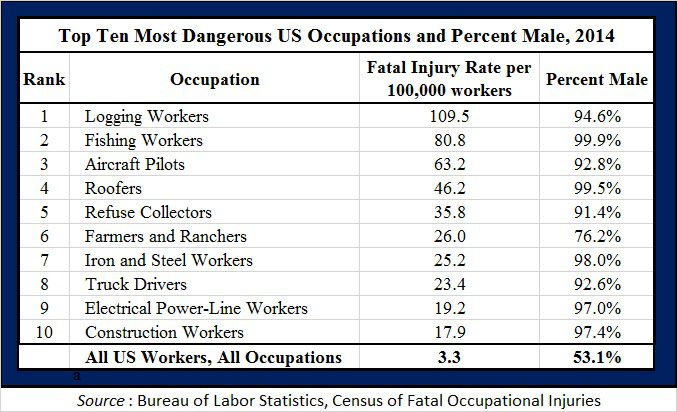“Equal Pay” Day
April 11, 2016

TOMORROW is “Equal Pay Day,” the annual event celebrating feminist lies about wage differences between men and women.
Equal Pay Day is an embarrassment to women everywhere.
Equal Pay Day is an offense to the intelligence. Only those with limited practical experience or the inability to reason would come to the conclusion that the reason why women in general earn less money than men is prejudice against them.
Equal Pay Day should be rejected and mocked by women everywhere.
Leaving aside the fact that women’s employment tends to be interrupted more often and that women are (and should be) less ambitious, one obvious reason why women in general are paid less is that they work in less dangerous occupations.
It is not fair — not fair at all — that more men are killed on the job. Is this disparity the subject of national campaigns? No, it is not. Highlighting the greater deaths of men does not further the war against human freedom and social order, so it is not a banner waved by feminists.
Mark Perry from the American Enterprise Institute writes:
Every year the National Committee on Pay Equity (NCPE) publicizes its “Equal Pay Day” to bring public attention to the gender pay gap. According to the NCPE, “Equal Pay Day” will fall this year on April 12, and allegedly represents how far into 2016 women will have to continue working to earn the same income that the men earned last year, supposedly for doing the same job. Inspired by Equal Pay Day, I introduced “Equal Occupational Fatality Day” in 2010 to bring public attention to the huge gender disparity in work-related deaths every year in the United States. “Equal Occupational Fatality Day” tells us how many years into the future women will be able to continue to work before they will experience the same number of occupational fatalities that occurred for men in the previous year.
The Bureau of Labor Statistics (BLS) released data last fall on workplace fatalities for 2014, and a new “Equal Occupational Fatality Day” can now be calculated. As in previous years, the chart above shows the significant gender disparity in workplace fatalities in 2014: 4,320 men died on the job (92.3% of the total) compared to only 359 women (7.7% of the total). The “gender occupational fatality gap” in 2014 was considerable — more than 12 men died on the job last year for every woman who died while working.
Based on the BLS data for 2014 (and assuming it will be comparable to 2015 data when it becomes available), the next “Equal Occupational Fatality Day” will occur about 12 years from now – on January 12, 2027. That date symbolizes how far into the future women will be able to continue working before they experience the same loss of life that men experienced in 2015 from work-related deaths. Because women tend to work in safer occupations than men on average, they have the advantage of being able to work for more than a decade longer than men before they experience the same number of male occupational fatalities in a single year.
Economic theory tells us that the “gender occupational fatality gap” explains part of the “gender pay gap” because a disproportionate number of men work in higher-risk, but higher-paid occupations like coal mining (almost 100 % male), fire fighters (94.3% male), police officers (87.6% male), correctional officers (71.4% male), logging (94.6% male), refuse collectors (91.4%), truck drivers (94.2%), roofers (99.5% male), highway maintenance (98.5%), commercial fishing (100%) and construction (97.4% male); see BLS data here. The table above shows that for the ten most dangerous occupations in 2014 based on fatality rates per 100,000 workers, men represented more than 91% of the workers in those occupations for all of the ten occupations except for farming, which is 76.2% male.
In order for wages to be more “equal,” many more women would have to die on the job. It’s true, that would probably make Gloria Steinem happy. But is that what most women want? It doesn’t matter. Even Gloria cannot force women to become fishermen and truck drivers.
— Comments —
Paul C. writes:
Fishing is more dangerous than roofing (mainly slant roofing), not something anyone with sanity would do unless pressed hard for money.
Still, all roofers fall off of rooves; but they usually don’t suffer awful injuries. All boat fishermen have many harrowing experiences, but usually they don’t suffer awful injuries. It has always been my impression that construction workers have the most dangerous job because they must rely heavily on their co-workers’ carefulness. But your stats show otherwise. I suppose it is because I started out in insurance defense litigation and a senior member of the firm told me construction and other manual labor comprised a slaughterhouse. Our practice also defended against workers’ compensation claims. But it was always by way of settlement because we and our clients knew the men deserved their compensation, which is pitiful. There were technical defenses we rarely had to use, fortunately.
